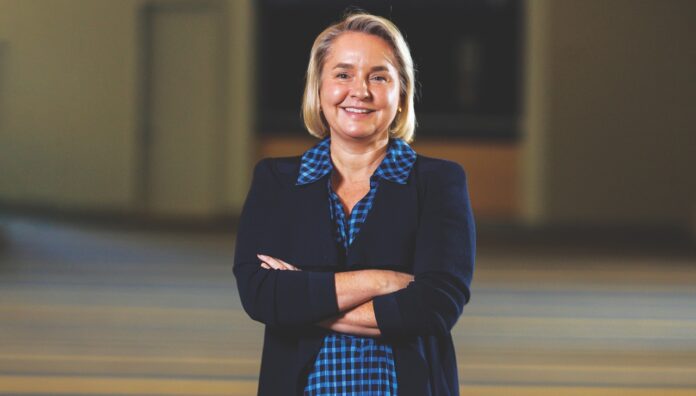Karen Castle MPS, PSA’s newest policy pharmacist, writes healthcare legislation and knows quite a lot about voluntary assisted dying requirements.
How did you become a policy pharmacist?
Straight out of high school, I did a Bachelor of International Business with visions of working in foreign affairs and aid. My first job was in the export finance division of a multinational bank, but I was always interested in health, wellness and the science behind medicines.
So, at 25, I went back to uni to study pharmacy. After 10 years in community pharmacy, keen to expand my horizons, I enrolled in a Master of Public Health course. One of my first subjects was epidemiology – a field I had never heard of but found fascinating and majored in.
At the same time, I decided to change up my pharmacy practice and successfully applied for a job as a clinical pharmacist at the Royal Brisbane and Women’s Hospital. About a year later, a friend from the Queensland Department of Health told me about a pharmacist role on a project redesigning the medicines and poisons legislation.
The Medicines and Poisons Act was passed in 2019. When it commenced 2 years later, the Queensland Parliament passed the Voluntary Assisted Dying Act 2021. I was offered the consultant pharmacist role on the implementation team for this legislation.
In another twist of fate, just as my role on the implementation team for voluntary assisted dying (VAD) was winding down, I heard about an opportunity to be a policy pharmacist for PSA.
What’s the role of a pharmacist in implementing new policy such as VAD?
My team was working to ensure the safe and effective implementation of VAD in Queensland in the 15 months from when the legislation passed to its commencement on 1 January 2023.
One of my main deliverables was developing the clinical protocols used by medical practitioners and nurses involved in VAD. I extensively researched what was happening in other countries and states where VAD was already available, and convened a panel of clinicians to assist with the development of the clinical protocols.
I was also tasked with figuring out how to safely and effectively supply and dispose of the VAD substance. Queensland’s population is very decentralised, which presented major challenges when working out a safe and effective distribution model.
I was in the role for a further 6 months after the Act commenced, and the team transitioned from implementation to maintenance of the scheme. This involved reviewing completed cases to identify areas for improvement and issues of non-compliance with the legislation.
Before becoming involved, I was conscious of the ethical and religious considerations surrounding VAD, but I didn’t hold particularly strong views. Now I believe people should be able to have control over their lives and deaths. People suffering and in pain were anxiously awaiting the commencement of the legislation so they could have a ‘good death’, and it was a privilege to play a part in facilitating that.
There are a lot of safeguards, which translate to checks, balances and corresponding paperwork for medical practitioners. There is limited funding available to support practitioners in private practice to deliver VAD services, and most freely give their time because they believe so strongly in its availability.
What are the standout updates to the Medicines and Poisons Act 2019?
A major part of the rework was to modernise how the legislation is written. The Medicines and Poisons Act 2019 replaced the Health Act 1937, so it needed updating. One of my favourite things in the original Act were the definitions. For example, a vehicle was defined as ‘any motor vehicle, omnibus, coach, cart, sulky, bicycle, velocipede, train, railway carriage, aeroplane, airship, balloon or other means of conveyance or transit’.
Key policy changes included enabling real-time prescription monitoring, age restriction removal for supply of Schedule 3 medicines, and enabling a range of health practitioners to destroy unwanted Schedule 8 medicines on site rather than having to send them for destruction.
The future of pharmacy practice?
I see pharmacists increasingly integrated into care teams, working collaboratively with medical, nursing and other allied health practitioners in community settings – including general practice, community pharmacy and aged care facilities. But this will require appropriate funding arrangements and the removal of regulatory barriers.
A day in the life of Karen Castle MPS, Policy Pharmacist, PSA, Brisbane
| 7.00am | Morning walk
Every day starts with a walk for my dog, Minty, while listening to an audio book. There are plenty of walking tracks – and swooping magpies! – around my neighbourhood. |
| 8.30am | Scope of practice update
Summarising pharmacist scope of practice pilots either underway or soon to start, highlighting areas of difference and similarity so PSA members are informed on progress. |
| 11.00am | Queensland Scope Pilot
Attend working group meeting with Queensland Government, PSA and other stakeholders designing and implementing a state trial of pharmacists working to full scope. |
| 12.30pm | Lunchtime
I like to hole up in a plant nursery opposite PSA’s office in Brisbane’s West End that stocks unusual and exotic plants. |
| 1.30pm | Weekly catch-up
PSA Policy Team meeting to collaborate on responses to consultation papers and submissions on national scope of practice and Queensland Women and Girls’ Health Strategy. |
| 3.00pm | Disability awareness training
Attend training session focused on promoting awareness of disability and strategies to ensure staff workplaces are inclusive and supportive. |
| 4.30pm | Advice and policy changes
Respond to queries from PSA staff and members seeking advice on regulation or policy changes, including 60-day dispensing, salbutamol rescheduling, and changes to the NIP schedule, including for herpes zoster. |
| 6.00pm | Fortnightly pharmacy shift
Work an evening shift every 2 weeks in the community pharmacy I have worked in for over 20 years. Great to maintain connection with patients and helpful to keep abreast of what’s impacting pharmacists on the ground. |



 Pharmacists have always prescribed, but they have the potential to prescribe much more
Pharmacists have always prescribed, but they have the potential to prescribe much more



 Sponsorship information
Sponsorship information


 Talking to patients who have questions
Talking to patients who have questions







